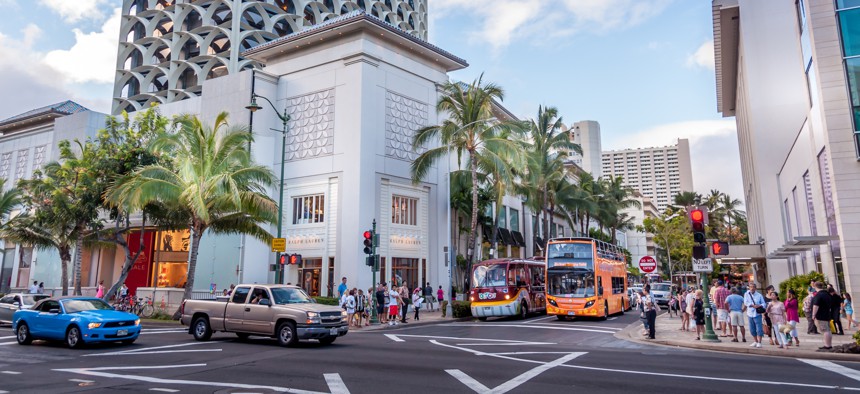How One State Used Technology and Data to Improve Traffic and Reduce Emissions

Famous Kalakaua Avenue in the evening in Waikiki, Hawaii. istock.com/jewhyte
COMMENTARY | Hawaii’s DOT added artificial intelligence technology across major roads and intersections to reduce per day traffic by seven minutes per person and 140 metric tons of carbon dioxide emissions.
The transportation industry is responsible for one-third of greenhouse gas emissions in the United States—the largest of any sector. While experts agree there must be large-scale reform efforts made to halt the effects of climate change, there are many ways that local government leaders can work with the innovation and technology sectors to reduce the transportation sector’s carbon footprint and improve environmental outcomes.
For instance, Hawaii’s Department of Transportation added new technology across major roads and intersections that reduced traffic by seven minutes per person per day, which significantly impacted Hawaii’s air quality—even during a lower-than-usual travel season for the state. Ultimately, this initiative cut back on 140 metric tons of carbon dioxide emissions per day, or 51,100 metric tons per year, and it’s just getting started.
So how did Hawaii do it?
Government leaders prioritized a data-centric approach
For departments of transportation and other government agencies, data is becoming increasingly important. Not only does it help these organizations prove that their actions are driving results that benefit the greater community, but it also helps them better manage their internal resources and prioritize projects.
HiDOT identified 30 traffic lights in strategic locations along major corridors on the big island to collect high-fidelity travel time, speed and origin/destination data. Over the course of a month, the state then installed traffic sensors that passively read the signals of electronic devices as they passed by, providing real-time traffic data at nearly any time or place. After collecting data for about 30 days, HiDOT was able to identify “problem corridors” and adjusted traffic signal times in a way that shaved several minutes off of a commuter’s travel time, while simultaneously reducing emissions.
State sought technology to provide real-time data and insights
The transportation industry has a long history of adopting technology to help traffic engineers do their jobs, and that technology is continuing to evolve with adaptive signal timing, ramp meter optimization, ride-sharing and connected vehicle technologies. When Hawaii looked for a tool to reduce emissions and traffic, they implemented a real-time traffic monitoring system to streamline the data collection and analysis process.
However, having the technology to make a change and the desire to implement it isn’t enough. Government agencies are still constrained by budgets, politicking, making decisions based on ample research and appealing to their constituents. While government entities are often hesitant to invest precious, highly scrutinized resources in untested tech solutions, partnerships with the innovation community have helped provide research and grants to prove the value of technology applications.
For instance, HiDOT was able to install artificial intelligent traffic sensors through a grant provided by an innovation organization called Elemental Excelerator. Without a partnership between all three organizations, it may have taken much longer to test this technology and see the results it has made on commutes and emissions.
There are many other potential applications for artificial intelligence and data to improve roadways and infrastructure. For instance, many departments of transportation have directors of innovation leading exciting projects like using AI technology to reduce trash, by using cameras to track when garbage cans are full and if they contain any recyclable material.
Another example is how Utah’s DOT recently adopted new technology that uses crowd-sourced video data to target specific areas where roadway maintenance is needed most—from refreshing paint lines to fixing potholes and other road safety issues.
Case studies from these technologies point to a new way for governments to make smarter decisions backed by on-the-ground, up-to-the-minute data.
Now it is more crucial than ever for the government to apply the best technology and ideas to our roads amid the ongoing climate crisis. If the innovation, technology and government communities can work together, we may be able to see new technology implemented in time to make a difference to our environment.
Mark Pittman is CEO of Blyncsy, a technology company.
NEXT STORY: Air Force plans 3D scans of facilities





